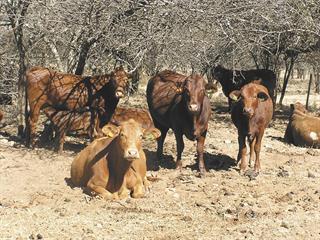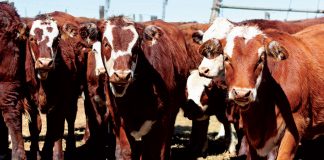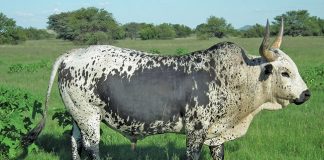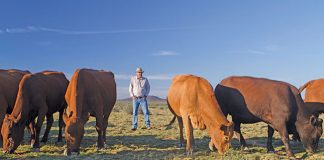
The Fodderbank Grazing Management System (FGMS) was introduced to Limpopo in 1997 and many commercial farmers there received it favourably. But it’s also suitable for communal areas, says Dr Jorrie Jordaan of the Towoomba Research Station, Bela Bela, Limpopo.The FGMS meets most requirements for sound veld management in the northern bushveld and provides a framework farmers can use to apply the basic principles of veld management.
With minor variation, it can be applied in all savannah and bushveld areas in sub-Saharan Africa.Jorrie explains the system can work almost anywhere in the world – outside the tropics and snow belts – although some sourveld areas might present problems when herbage quality drops in winter.“But in savannah and bushveld veld types the reaction of the grass component will probably be similar, as it needs defoliation to stimulate growth and rest to recover,” says Jorrie.
Veld condition and animal performance
After decades of debate about how to turn around South Africa’s veld degradation, researchers agree that veld condition and animal performance is determined by three crucial factors. “These are separating plant communities, maintaining a realistic stocking rate, and sporadic, long rest periods during the growing season,” says Jorrie. “These maintain veld condition and animal production, irrespective of the grazing management system used.”Since 1966 researchers have recommended rotational grazing, mostly in multi-camp systems with short grazing periods.
These systems seemed to counteract selective grazing behaviour.“Those who promoted these systems saw their high costs in terms of fencing and water supply as part of the package, and they were applied as ‘veld management recipes’,” Jorrie explains. “The outcome was usually fast rotation without specific management objectives. Eventually, scientists realised that these systems were based on inaccurate assumptions.“Since then, more information has led to adjustments that have dramatically improved rotational grazing systems.”
He says the FGMS makes veld management based on scientific principles relatively easy and cheap. First, the veld is divided in thirds in camp groups.“Each camp group is grazed continuously for four months by the total number of cattle that the farm can carry,” explains Jorrie. “In this way, the entire farm is grazed annually, but only one third is grazed during the active growing season. The next year, a different third of the veld will be grazed during the growing season.” (See Table 1: Sequence of rotation for the three camp groups).
How it works
Veld types must be fenced off, and the relative production potential and area of each plant community determined relative to one another. The farm is then divided into three groups or camps, each with a similar production potential and carrying capacity/potential.In other words, each group will consist of about one-third of each veld type on the farm (See Figure 1).The three groups must accommodate the same number of cattle. Homogenous areas will need fewer camps per camp group.
The calendar year is divided into three equal periods. One period covers the peak growing season, which corresponds with peak rainfall. In Limpopo, this is between early December and late March (four months), while the dormant season occurs between early April and late November (eight months). Jorrie says the best time to start is at the start of the growing season. Thus, on 1 December, all livestock is moved to one-third of the farm’s veld for four months until the end of March.Thereafter, the next third of the farm is used for a four-month period (April to July, the early to middle part of the dormant season for grasses), followed by the last third (August to November, the middle and last part of the dormant season).
Advantages of the system for grasses:
Day-to-day management is simple. After the initial planning, relatively little time and few management inputs are needed.Fencing costs are low – a minimum of three camps per herd. There are normally at least three herds on a farm.Rest – Two-thirds of the veld rests each year during the growing season.
Fodder flow – grazing a third of the veld during each third of the year makes provision for an annual fodder flow.The farmer can easily adjust the stocking rate to fit the rainfall record. For example, if a camp group is fully used by February (75% of the growing period), the farm is 25% overstocked.
Fodder shortages will then occur during the other two grazing periods.
Plant communities are used separately. For optimal use, separating veld types is very important.
All grazing management systems can be adapted to incorporate the principles of the FGMS without major changes. For instance, someone who uses the controlled selective grazing system (CSG) can keep all livestock on a third of the farm, using CSG, and rotate the different thirds according to the FGMS.“But remember, the stocking rate must be within the farm’s total carrying capacity,” warns Jorrie.
The truth about veld management systems
Based on various long-term grazing-management trials throughout southern Africa, there is no scientific evidence that rotational grazing is better than continuous grazing, and vice versa. But Jorrie points out how numerous trials have shown that:Selective grazing can’t be “improved” by adding more camps to a rotational system.Under continuous grazing, animal production is equal to or higher than under rotational grazing. Under rotational grazing there is an initial drop in livestock production when animals enter a new camp.
This isn’t a factor under continuous grazing.Veld condition differs little between continuous and rotational grazing. Continuous grazing in itself doesn’t seem to present a problem, but continuous overgrazing is the main reason for veld deterioration.Applying rotational grazing doesn’t increase carrying capacity.The stocking rate (MLU/ha/year) and adequate rest are the two most important factors influencing animal production, irrespective of the grazing system followed.“Good veld management starts with the grazing process, not the grazing procedure,” says Jorrie.
“The effect of selective grazing is more important than selective grazing itself. First the total negative effect of grazing must be considered, and thereafter attention can be given to aspects such as grazing management systems and the number of required camps in terms of practical herd management.”
Veld management tips
Veld must rest long enough to overcome the effect of previous grazing on grass and seed production, but not enough information is available to indicate how long an effective rest period should be. “Grasses probably need a full growing season to recover after defoliation,” says Jorrie. “Grazed veld that gets no rest progressively deteriorates.”There is a theory that high stocking rates can increase carrying capacity because the stimulation will increase grass production, but Jorrie says this idea is totally unfounded.“Where research has shown that rotational grazing increased carrying capacity, this only lasted for the first growing season. After that, grass vitality and veld condition decreased over time.”
In fact, stocking rate is determined by available material, which depends on climatic conditions, veld type and veld condition. It can’t be changed by changing the grazing procedure. “Overstocking is the most important factor that leads to veld deterioration,” warns Jorrie. “Don’t overstock your veld and then try to fix the damage with a long rest. The veld will recover partially, but not enough to regain its previous condition.”Jorrie emphasises that each farm’s carrying capacity is unique and varies between years. Since grass production varies from year to year, stocking rates must also be adjusted annually. The norms set by the agriculture department are only a guide – farmers must make the annual adjustments themselves. Contact Jorrie Jordaan on 082 886 6792 or e-mail [email protected]. |fw













